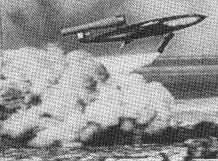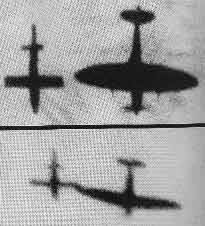|
|
|
Other Weapons |
V-1 |
Armour of the Reich | |




| 
Note the small propeller on the nose
of the V-1 picture on the left. Turns
represents miles. After the calculated
range was reached, the propeller stopped
turning. That was the means to cut the
engine, if all went well, over the target.
|
| CROSSBOW, the air battle against V-1 weapons |
|
Since 1943 allied agents and arial photographic reconnaissance had kept
Allied Intelligence informed on flying bombs. They were developed at an
experimental station on Peenemünda, an island in the Baltic Sea,
strange concrete launching platforms had been built for them along the
coasts opposite England. Both Peenemünda and the launching sites were
treated to continued heavy doses of Allied bombing, but on June 13, a week
after the D-Day landings, the first flying bomb hit London.
It was what the Germans called the V-1, and what the Londoners eventually dubbed the "buzz bomb" or "doodlebug." The V-1 was an unmanned jet plane with a 1-ton explosive warhead. It flew about 3000 feet high at speeds up to 400 miles an hour and had a 250 mile range. Steered by a magnetic compass it was easily able to hit large target areas, like London. During the three months of the summer of 1944, the Germans launched an average of 100 "buzz bombs" daily at England, a total of about 8000, but only a third , 2400, pierced the protective belts of fighter planes, antiaircraft guns and barrage balloons. Even so the V-1's killed 6184 people and injured 17,981, and caused considerable damage to the city, but they did not undermine British civilian morale. Realizing they could only delay, and not stop, the German missile offensive, British experts set up around London three defensive measures: barrage balloons, antiaircraft batteries and fighters. Although these defenses were not effective against the 1,837 supersonic V-2's that were fired at England beginning in September of 1944, they had great success against the V-1 flying bombs. Some British pilots learned how to climb above the V-1's, dive to overtake them and eigther explode them with gun fire or tilt them over with a wing tip so they crashed.
Of the nearly 11,000 V-1's that crossed the cost of England starting June 13,
1944, more than one third were destroyed before they could reach their
targets. Of those that reached the target area, two thirds overshot because
of falsified targeting information supplied to the Germans by double agents
in England.
Some interesting facts
|
| HOME | BACK | TOP |